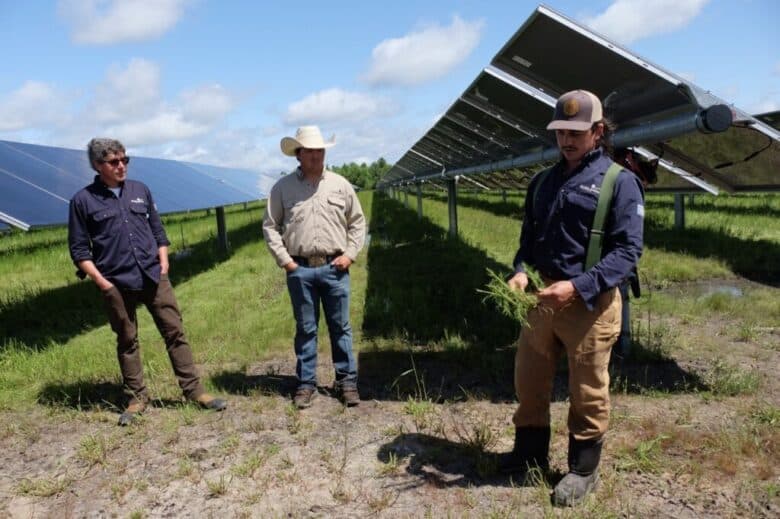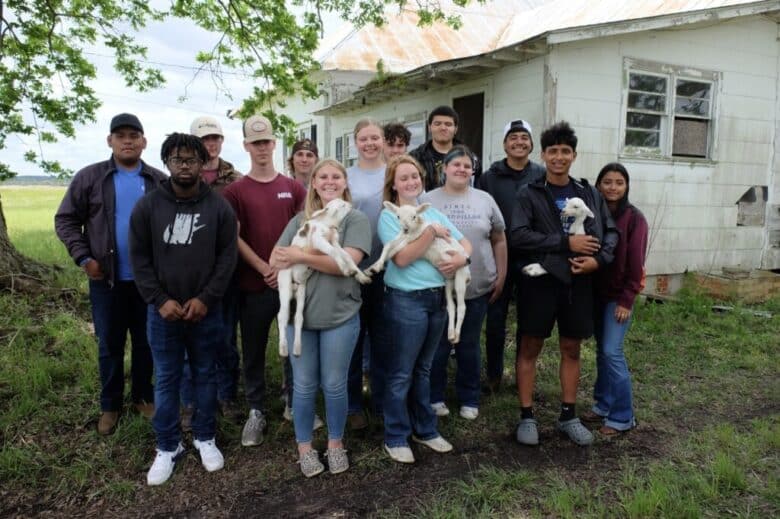Power to the People and the Farmers that Feed Them
Silicon Ranch’s Regenerative Energy® Bolsters Local Control and Agricultural Economies
Posted by Jim Bausell
Quick Summary
- The birth of the electric cooperative brought local autonomy, prosperity, economic development, and hope to rural U.S. communities
- Today, combining clean solar energy generation and food production on one piece of land creates a new positive future for rural agricultural communities, economies, and ecosystems
- Regenerative Energy®’s marriage of managed sheep grazing and solar farms adds value to land and creates traditional, long-term jobs for the rural workforce and generations to come, as well as new revenue streams for farmers and ranchers
- This creates a stable and more profitable future for rural families and helps build decentralized and resilient food systems to ensure families are fed
- While keeping solar land in agricultural production, marrying clean power generation and regenerative agriculture restores healthy soils, grasses, air, and water
- As a long-term land and asset owner, Silicon Ranch is often the largest taxpayer in the county, supporting the local school system and government services
- Economic and social benefits of Silicon Ranch projects touch every community member
The energy transition is the first big opportunity of the 21st century to revitalize the roots of the electric cooperative business model. This transition is delivering clean power — affordable and resilient energy — all locally produced. It is returning control of power generation to the local community, to its economic benefit. And it can combine renewable energy generation with farm production, making solar do more, to the advantage of local communities, their economies, and their ecosystems.
To be clear, we’ve come a long way, baby, yet the road ahead is even brighter for rural communities.
Back in the early days nine out of ten rural home were without electric service
Imagine life in the rural United States back in the 1930s. The depression had been harsh on the countryside.
Nine out of ten rural homes were without electric service. The farmer milked his cows by hand in the dim light of a kerosene lantern. His wife was at the wood range and washboard all of her waking hours. The unavailability of electricity in rural areas kept their economies exclusively tied to agriculture. Factories and businesses, of course, preferred to locate in cities where electric power was prevalent.
The ravages of illiteracy, poor medical care, low disposable income, and high unemployment weighed heavy. To be clear, any meaningful economic development that might lift rural communities up just wasn’t on the horizon.
That changed when the Rural Electrification Act of 1936 created hundreds of locally owned electric cooperative utilities and funded electric distribution systems
Electric cooperative utilities turned on the lights across the rural U.S.
People became excited as the lines stretched farther and farther into the countryside. Everyone was anxious to get his or her home wired for electricity. As the lights came on, one elated farmer was overheard saying: “When I pulled that chain to turn on the lights, I felt as though I had been living in the dark all my life. Electric lights give me so much more light than my kerosene lamps, and I don’t have to smell the smoke.” Another Tennessee farmer, when asked to give his testimony at a local church, stood up and said, “Brothers and sisters, I want to tell you that the greatest thing is to have the love of God in your heart, and the next greatest thing is to have electricity in your home.”
But the birth of the electric cooperative also meant political, economic, and local energy decision-making was squarely in the hands of local communities. Everyone in the community is a “member” of an electric cooperative, an owner, if you will, responsible for electing the board and selecting the leadership for the utility. Power was in the hands of the people, in all ways.
The birth of the electric cooperative was a revolution that brought prosperity, community, economic development, and hope to the rural U.S.
Fast forward 80 years: Regenerative Energy® offers a new positive future for rural communities and U.S. farmers
Today, electric cooperatives are working to create innovative clean energy solutions for agriculture operations, and approximately 80 percent of U.S. farms are in counties served by these cooperatives.
Silicon Ranch presents electric cooperatives with a unique solution — Regenerative Energy® — locally sourced, locally generated, clean electricity married with regenerative agricultural production on one piece of land
The marriage of managed sheep grazing and solar farms benefits people, land, the environment, and the local economy
New land value, jobs, revenue, and food for farmers and their families
Regenerative Energy® adds value to land and creates traditional, long-term jobs for the rural workforce and generations to come, as well as new grazing pastures and payments that boost income for farmers, ranchers, land managers, and rural communities across the U.S. This produces a stable and more profitable future for families and helps meet the need for decentralized and resilient food systems to ensure families are fed.

Restored health for soils, grasses, air, and water
While keeping solar land in agricultural production, combining clean power generation and regenerative agriculture restores healthy soils, grasses, air, and water by increasing the cycling of nutrients, carbon, and water. Adaptively managed grazing sheep rotate into new pastures on the solar farm depending on rain and vegetation, keep the grass from shading the panels, and alleviate the need for the use of herbicides and synthetic fertilizers. The sheep naturally fertilize the land and trample hay and seeds into the soil, strengthening root systems, while we provide shelter, shade, and food for the sheep.

Economic and social benefits that touch every community member, kids included
Silicon Ranch projects mean a large capital investment in communities with little capital investment. We own, operate, and maintain each of our solar ranches for the life of the project, and we are committed to being a good citizen and neighbor in each of our communities. As a land and asset owner, we are often the largest taxpayer in the county, providing significant new tax dollars that are invested back in the community, supporting the local school system and government services. Silicon Ranch also supports electric cooperatives in their educational outreach to teach students about the energy transition, regenerative agriculture, and the associated solar industry career opportunities.
We reaffirm how the seven cooperative principles are followed by electric cooperatives
Silicon Ranch is committed to the principles of local autonomy in energy decision-making, concern for community, and members’ economic participation. This commitment is observable in the seven cooperative principles, which are followed by electric cooperatives. With local Regenerative Energy®, members achieve high returns on the energy investment, attaining better economic outcomes for the community while in full control of their energy future.
As we first witnessed back in the 1930s, power once again is returning to the people. Tonight, as we all look out and see the lights come on across our communities, consider this: the electricity is clean, locally sourced and controlled, and powering the positive agricultural and economic future of our community. This can only make our rural communities more vibrant and resilient in the long run.